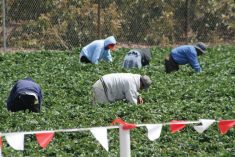It’s been two years since Canada struck a much-heralded trade deal with Europe — but so far, it’s produced meagre results.
And when it comes to grain exports, things have actually gone backwards.
“Italy has brought in country-of-origin labelling on pasta to identify Canadian durum and ensure that it’s not used in making pasta,” said Tom Steve, general manager of Alberta Wheat and Alberta Barley.
“They’re labelling Canadian durum as an inferior product in their market, and they’re using all of the trade obstacles that they can to prevent Canadian durum from getting into their market.”
Read Also

Farming Smarter receives financial boost from Alberta government for potato research
Farming Smarter near Lethbridge got a boost to its research equipment, thanks to the Alberta government’s increase in funding for research associations.
Prior to the Comprehensive Economic and Trade Agreement (CETA), Italy bought about a million tonnes of Canadian durum annually. That dropped to about 700,000 tonnes in the 2016-17 crop year and just 350,000 tonnes in the current one.
“It’s dropped off in recent months to virtually nothing, and we’re very concerned about that,” said Steve. “We certainly thought that, with CETA, we would be able to maintain or expand our footprint in Italy, and that’s just not happening.
“We’re in a position where our durum growers are losing out and have already lost out on markets.”
Although not fully ratified (all 28 EU member states must formally approve it), the provisions of the trade deal with Europe largely came into force a year ago. It offers duty-free access for Canadian grains to European markets, which historically charged anywhere between $120 per tonne to $190 per tonne depending on the crop. That reduction in tariffs was expected to increase grain and oilseed exports to the European Union by up to $100 million a year.

But a reduction in tariffs means very little when a key trading partner slaps country-of-origin labelling on Canadian crops, said Steve.
The wheat sector has called on Ottawa to make a formal complaint to the World Trade Organization but so far, the feds have chosen to address it through “diplomatic means,” he said.
“We’ve been trying to put pressure on the federal government to take meaningful action, and to date, it’s been sympathetic to our concerns but it hasn’t been as aggressive as we would have liked it to be,” said Steve.
“What is the point of signing trade agreements if they’re not going to be enforced?”
Slow progress onother fronts
It’s largely been status quo for other grains, as European demand for Canadian spring wheat, barley, pulses, and canola has been relatively low, and that hasn’t changed since the agreement was signed.
“Europe has never been a big export market for us, so we really haven’t seen a dramatic increase in canola oil sales to European countries,” said Ward Toma, general manager of Alberta Canola.
“It’s essentially self-sufficient in vegetable oils. So what the canola industry and canola farmers got out of the CETA agreement was never going to put money in our pockets at all.”
However, the deal will be helpful when it comes to gaining approval for new products.
“The more important thing — and it’s not something that’s going to impact a farmer’s bottom line — is that they made a commitment to be a bit more timely in regulatory approvals,” said Toma, adding there has already been some progress on that front. “That was a huge step forward for us.”
But Canada’s beef industry hasn’t been so lucky in getting its own regulatory burdens lifted in Europe.

“It’s great that we have this tariff-free quota, but our ability to use it is restricted by the fact that our two major processors are using absolutely safe carcass washes that aren’t approved for Europe,” said Rich Smith, executive director of Alberta Beef Producers.
“We welcome two-way trade, and we’d like support in removing the restrictions to our exports.
“It’s been frustratingly slow for us to get that done.”
As with canola, Europe has not been a major market for Canadian beef, but export volumes are up around 25 per cent compared to last year. But only one of Canada’s major packers is shipping cattle there because of the restrictions around carcass washes, and as a result, producers haven’t yet jumped on board with producing cattle that meet the European requirements for hormone-free beef.
“Because the main plants haven’t fully embraced that market, there hasn’t been the signal to producers to go through the process of getting the certifications they need to sell cattle to the EU,” said Smith.
“We’re still seeing some constraints on the number of cattle that are available, so we’re still way below our quota-free access. There are estimates that the European market could become a $300-million market, and right now, we’re at $5.4 million.
“I think it will grow. It’s just taking some time because of some of these barriers.”
Europe has issues, too
There are similar complaints on the other side of the Atlantic.
Canada agreed to more than double tariff-free imports of cheese over five years, starting a year ago. But only 36 per cent of the high-quality cheese quota has been used as of early September.
“We were hoping and expecting to significantly increase our Canadian sales,” Attilio Zanetti of Italian cheese company Zanetti told the Reuters news agency.
Under the deal, Canada set aside half of the new quota for Canadian cheese makers, an indirect support as they face new competition. The rest went to Canadian retailers and distributors based on their market share, including sales of Canadian cheese.
From the start, the European dairy industry argued that Canadian cheese makers would use their quota to limit competition by importing selectively or not at all. (But refusing to import could backfire for Canadian companies, as they could lose the right to import in future under the terms of the CETA quota system.)
Major Canadian dairy companies, including Saputo and Agropur, hold quotas. But in a break from the past, Canada also divided quotas between many companies, allocating 60 per cent to small firms. That fragmentation has made it difficult to import profitably, especially this year, according to quota holders, as allocations start small and rise each year.
Alberta retailer and pork producer Sunterra Group, a new quota holder, will use all its quota to import nearly four tonnes of Parmesan from Italy this year, Sunterra president Ray Price said. But it was a challenge to ship so little, since cheese is transported in 18-tonne containers. Price would rather buy four times more.
“If you’re a small organization, I can see where people would say, ‘I’ll do it next time,’” he said.
The Pacific promise
While supply is one of the major barriers of Canada’s cattle sector, lack of demand is hurting Canada’s pork exports to the European Union.
“At the end of the day, it’s better for us to ship it somewhere else versus going in to the EU where the market is already saturated,” said Darcy Fitzgerald, executive director of Alberta Pork.
“We have a lot more customers we can go to in the Pacific Rim, so that will be a better market for us. Having the Trans-Pacific Partnership (TPP) signed will be a big bonus for us. It’s opening a lot more doors for us with countries that really want our products.”
The Trans-Pacific trade deal “is a total different ball game,” said Toma.
“The demand side in the Asian rim for canola products is monstrous,” he said. “If we’re in the agreement at all, it will increase sales and movement within the first year.
“Either we’ll be shipping more stuff or getting a better price at the farm gate because more people will be bidding on our product. The TPP is way more important to the canola industry.”
Steve agrees.
“Those are more natural markets for us than Europe,” he said. “We’re optimistic about TPP and we’re trying to be optimistic about a resolution to NAFTA as well.”
Like the European trade deal, the Trans-Pacific agreement will provisionally come into force prior to full ratification. (In this case, once six of the 11 nations party to the deal ratify it.)
The North American Free Trade Agreement has only heightened the urgency to sort out restrictions in the European deal and ratify the Trans-Pacific one, Smith added.
“We sell three-quarters of our exports to the United States,” he said. “If you only have one market, it can really get you into trouble in a hurry if something happens in that market.”
For an export-dependent country like Canada, trade agreements are “absolutely crucial,” even if the results are slow to come, said Steve.
“We need to export roughly 70 per cent of our wheat crop, so if we don’t have access to those markets, we won’t be in business,” he said.
And while these trade agreements might not always put more money in a producer’s pocket, having them signed and ratified is the only way to access new markets should the opportunity arise, said Toma.
“We can’t eat all that we grow here — we have to send it away,” he said. “Every buyer is important. We never want to turn them away.
“If you have all of your eggs in one basket, you’ve got a problem.”
– With files from Reuters















